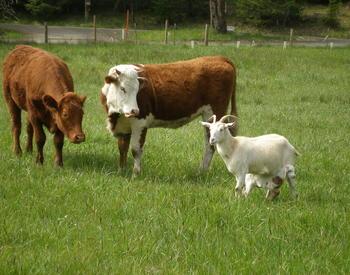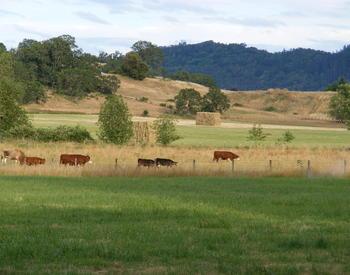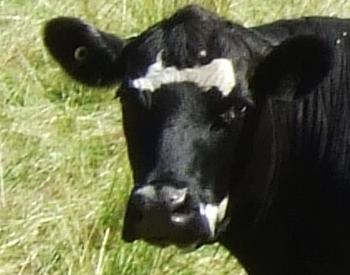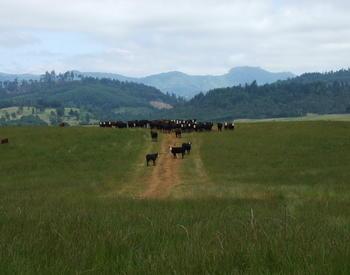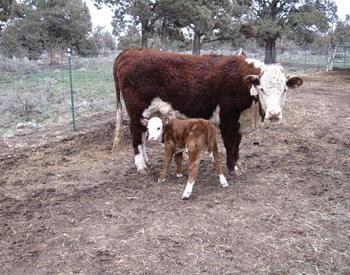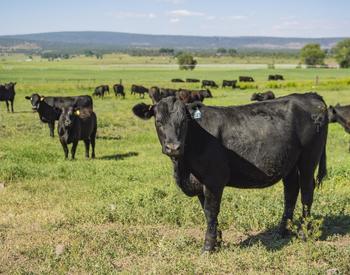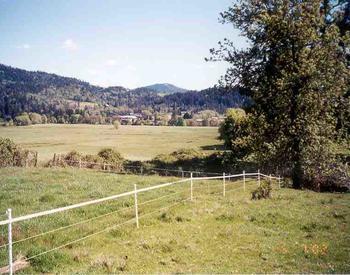Introduction
The main goal of a cow-calf operation is to produce one calf per cow per year. Sound reproductive management of the cowherd, using proven methods, is required to accomplish this goal in a manner that is economically efficient and sustains the natural resources of the ranch. A cow that fails to produce a calf for even one year can represent a net loss to the ranch. It is especially important for young cows that have not returned revenue greater than their own cost of development to continue to produce a calf each year. In many operations, a cow does not have this return until she has weaned her 5th or 6th calf. Cows that fail to rebreed in a timely manner also have economic inefficiencies that threaten the viability of a ranch.
This fact sheet reviews basic evaluation tools and management practices that impact the reproductive success of a cowherd. To make use of these materials it is best to complete an evaluation on your cowherd by calculating the various numbers (percentages and time periods) and review the management practices referred to in this fact sheet. As a follow-up, decide which areas need improvement, make a priority list, and then act accordingly.
Calculating reproductive rates
Pregnancy rate, conception rate, and calving interval are the most common and important indicators of reproductive efficiency of the cowherd (Hafez, 1993). Pregnancy rate accounts for the number of cows that become pregnant divided by the total number of cows in the herd. As an example, if 100 cows were exposed to bulls for 90 days, and 65 cows were pregnant after bulls were removed, the pregnancy rate of the herd was 65%. Conception rate only accounts for cows that were effectively serviced, which is difficult to determine in commercial situations when using natural service.
Consequently, conception rates are more appropriate to scenarios where cows are assigned to artificial insemination (AI) and thus unquestionably serviced. As an example, if 100 cows were inseminated and 45 became pregnant, conception rate to AI was 45%. In operations were cows are inseminated and then exposed to bulls, the producer can assess the reproductive efficiency of the herd by evaluating conception rate to AI, pregnancy rate to bulls, as well as overall pregnancy rate (AI + bull breeding). To accurately generate these rates, however, producers need to be able to differentiate pregnancies from AI and bulls. This can be accomplished by using different sire breeds for AI and natural service and/or wait at least 15 days after AI to turn out bulls, and then determine during the calving season if cows became pregnant to AI or bull breeding according to calf breed or calving date. A producer could also wait 5 to 7 days after AI to turn out bulls if early pregnancy diagnosis (before 80 d after AI) were utilized.
Recording calving date is also important to determine the reproductive efficiency of the herd by assessing when cows conceived. The earlier cows conceive in the breeding season, the earlier in the calving season they will calve. Calves born earlier in the calving season are heavier at weaning (Figure 1). Further, cows that become pregnant early in the breeding season and calve early the following year have greater chances of rebreeding (Leismeister et al., 1973). Date of conception can be estimated retrospectively by subtracting gestation length from the calving date. As an example, the average gestation length of Angus cows is 280 days. If an Angus cow calved on March 20, she likely became pregnant on June 13 of the previous year. Similarly, calving interval (CI) is the number of days between successive calving events. For example, a cow that calves on March 20 one year and on March 15 the next year has a CI of 360 d. It is useful to calculate CI for individual cows and for the herd as an average. A CI of no more than 365 d is desirable given that the goal of cow-calf operations is to produce one calf per cow every year.
What is a profitable pregnancy rate? What about conception rate? What sorts of rates are good for heifers, first calf cows, mature cows, AI, natural service, etc…? These are significant questions relevant to the reproductive and overall efficiency of cow-calf operations. Of course, the perfect scenario would be having all cows pregnant every year, which is extremely difficult, if not impossible, to achieve. On the other hand, each operation should have its own goals and manage the reproduction of the herd according to its resources to ensure economical viability of the production system.
Benefits of well-defined breeding and calving seasons
Most ranches will benefit from having well- defined breeding and calving seasons. The management of the herd is simplified when cows are in similar stages of the production cycle and consequently can be handled as one group; one single management strategy can be used for the entire cowherd, such as nutrition for appropriate stage of gestation, movement among pastures or rangeland, vaccination calendar, etc. This allows for better coordination of farm labor, management time, and control over input costs. Having calves born during a defined period also simplifies management requirements for calving assistance and calf care, and also benefits marketing opportunities by promoting uniformity in the calf crop. Further, by limiting the period that cows have available to conceive, a well-defined breeding season also distinguishes females with adequate or impaired reproductive efficiency, allowing for selection of cattle that are able to efficiently reproduce within the environment of each operation.
Which period of the year is the most adequate for initiating the breeding season depends on each particular scenario. Producers should consider input costs (especially feed resources and costs), labor availability, marketing opportunities, environmental conditions, and more. As an example, breeding/calving seasons can be set up to take advantage of a particular marketing scheme.
Compared to a spring calving herd, a fall calving one might have higher feed costs to overwinter lactating cows, but weaned calves hit the market when supply is lower and prices are higher. The producer may realize that a few input costs may be higher, but revenues from the system are large enough to offset input costs.
If a ranch is large enough, it may be feasible to have more than one breeding season so that there are both spring-calving and fall-calving herds within one ranch, for example. Some resources, like bulls, can be shared between the two herds. Rarely is it beneficial to have year-round calving, but there are instances when marketing benefits outweigh input costs, particularly on small farms with niche markets. Each manager must pencil out the costs and benefits of possible options. Whatever system is chosen, cows should be on a set schedule and not allowed to breed without definite management objectives. This allows the manager to evaluate cows for culling practices and only keep the most productive, efficient cows in the herd.
Pregnancy Diagnosis
Pregnancy diagnosis is a tool that can be used to make culling and other management decisions within cow-calf operations. Cows that do not become pregnant during the defined breeding season represent a loss for a ranch. The sooner these cows can be identified; the sooner decisions can be made to determine their fate. If the producer waits until the calving season to determine pregnancy status of the herd, a significant amount of resources (feeding, labor, facilities, etc.) will have already been spent to support open cows that will not produce a calf to offset these investments. By diagnosing pregnancy as early as possible after the breeding season, producers will be able to select an appropriate number of replacement females while identifying non-pregnant cows for immediate culling from the herd or alternate management of these open females for optimal marketing. For specific information regarding marketing of cull cows, see Feuz (2000).
Early pregnancy diagnosis is also important for detecting the presence of diseases and other environmental factors that can cause abortions and repeat breeding in cows. If a large number of cows were diagnosed as pregnant by an experienced technician/veterinarian early after the breeding season but did not calve, it means that these cows lost their pregnancy during gestation. Several factors can elicit abortion in cattle, including infectious diseases (e.g., brucellosis and leptospirosis), consumption of abortive substances (e.g., pine needle abortion), and stressful situations (e.g., heat stress, transportation, predation). For more information, consult the Animal Health Section of the Cow-Calf Management Guide. When cowherds are not evaluated for pregnancy until several months after the end of the breeding season, it becomes very difficult, if not impossible, to identify causes of low pregnancy rates. Identifying and addressing causes for abortions will not only improve overall pregnancy rate, but also increase the number of calves born early in the calving season. Currently, the following methods for pregnancy diagnosis are available:
Rectal palpation
The most common method for pregnancy diagnosis is rectal palpation, in which the evaluator inserts his/her hands into the rectum of the cow, and palpates the reproductive tract thought the rectal wall. Pregnancies can be accurately detected by trained personnel 40 to 50 days after conception. Producers need to be aware that early palpation and manipulation of the reproductive tract and embryo can cause pregnancy loss. However, producers can learn how to palpate cows and confidently diagnose pregnancy (generally at later stages after breeding) when the evaluator can actually feel the fetus in the cow’s uterus.
Transrectal ultrasound
With ultrasonography the evaluator inserts the ultrasound probe into the rectum of the cow, and visualizes the reproductive tract of the cow, including uterus, embryo/fetus (if present), and ovaries. Pregnancies can be accurately detected as early as 28 days after conception. However, the ultrasound and probe are expensive, and only highly-trained personnel (such as veterinarians) are able to perform this service.
Biochemical tests
Blood samples can be analyzed for the pregnancy-specific protein B, which is only synthesized by pregnant cows. Blood samples can be collected as early as 30 days after breeding for the test. However, this test can yield false positives if taken less than 90 days after calving due to carry-over effects from the previous pregnancy (Carpenter and Sprott. 2007). Additionally, answers from the blood tests often require 48 hours or more from collection to shipping to analyzing to obtaining a diagnosis. There is no chute-side blood test available at this time.
Strategies to maximize reproduction in beef females
Based on an average gestation length (280 d), beef cows should become pregnant within 85 days after calving to ensure a calving interval of 365 days. Cows experience a period of infertility following calving that may last 60 days or more, when they are physiologically unable to ovulate. The length of this period, called the postpartum interval, significantly determines the likelihood of cows becoming pregnant during the next breeding season (Wiltbank, 1970). Consequently, strategies that minimize the postpartum interval, maximize fertility, and prevent early pregnancy losses are required to ensure optimal reproductive and overall efficiency of cow- calf operations.
Several management approaches to enhance reproduction in beef females have been developed, and involve nutrition, health, genetics, and manipulation of reproductive function. Specific information can be found in the OSU Beef Cattle Library, as well as in the Cow-Calf Management Guide referred to above. In summary, beef producers should pay special attention to the following basic items to ensure optimal reproductive performance of the cowherd:
Nutritional status
The environmental factor that most influences cattle reproduction is nutrition. Cows should calve and enter the breeding season with a body condition score (BCS) of at least 5, which is typically considered the “critical” BCS for adequate calving and subsequent reproductive performance of beef cows. It is also desirable to have cows on an increasing plane of nutrition from calving through breeding. However, over- conditioning the cowherd can also be detrimental to reproductive outcomes (Figure 2). Improvements in BCS can be achieved via nutritional decisions, particularly forage management and supplementation programs.
Health and herd management
Beef cows are susceptible to a variety of diseases that are detrimental to reproduction. Hence, a sound herd health program is an essential part of any reproductive management system. Overall management of the herd, including planning of feeding programs, pregnancy diagnosis, and bull management, are also imperative factors for optimal reproduction. See BEEF044 within the OSU Beef Cattle Library for models of herd health programs and management calendars for Oregon cow-calf operations. Also, producers should provide special attention to calving assistance. Cows that experience dystocia and are not provided timely assistance will have difficulty in becoming pregnant during the subsequent breeding season.
Early weaning
Weaning calves early will reduce nutrient requirements of the cow, and allow transfer of nutrients from milk production to body functions, including reproduction. To immediately impact cow reproductive performance, calves should be weaned before the end of the breeding season. To impact reproduction for the subsequent breeding season, calves can be weaned a few weeks before traditional weaning dates. This may help very thin cows obtain adequate BCS at their next calving (Whittier et al. 2011). However, one of the disadvantages of early weaning is the additional expenses associated with calf feeding and care. Therefore, the reproductive benefits of early weaning have to offset the additional costs associated with calf management to ensure that this approach is economically viable.
Estrus synchronization and AI
Recent developments in estrus synchronization and AI techniques have improved the success with AI allowing beef producers to increase the proportion of cows conceiving early in the breeding season, as well as infuse new and improved genetics into the herd. On the other hand, these approaches require significant planning, handling of cattle, special facilities, and economical investment. Several synchronization + AI protocols have been developed, tested, and are currently available. Producers should select the protocol that is cost efficient and matches their operating system and management objectives. For specific information about this subject, see BEEF005 within the OSU Beef Cattle Library.
Heifer management
Replacement heifers and first-time calvers require different management than the adult cowherd, including specific nutritional regimens, different breeding and calving calendars, special attention to calving problems, etc. For more information about management of young cows, please see specific publications within the OSU – Beef Cattle Library and the Cow-Calf Management Guide.
Conclusions
Reproduction management of the cowherd is a crucial component of cow-calf enterprises because it determines the number of calves available every year. Beef producers should understand and pay special attention to reproductive rates of the cowherd, and adopt management strategies to correct deficiencies and/or improve reproductive outcomes. Reproductive success of beef females depends on several variables, including nutrition, health, genetics, environment, etc. Several approaches to benefit cattle reproduction are currently available; therefore, beef producers should carefully examine and adopt those that specifically address their needs.
References
Carpenter and Sprott. 2007. Texas Cooperative Extension. B1077.
Cooke et al. 2009. J. Anim. Sci. 87:4125-4132. Feuz, D. M. 2011. In: Cow-Calf Management
Guide, CL737.
Hafez, E. S. E. 1993. Reproduction in farm animals.
6th ed. Philadelphia, PA.
Lesmeister et al. 1973. J. Anim. Sci. 36:1-6. Whittier et al. 2011. In: Cow-Calf management
Guide, CL 747.
Wiltbank, J. N. 1970. J. Anim. Sci. 31:755-762.
This document is part of the Oregon State University - Beef Cattle Library. Prior to acceptance, this document was anonymously reviewed by two experts in the area.

